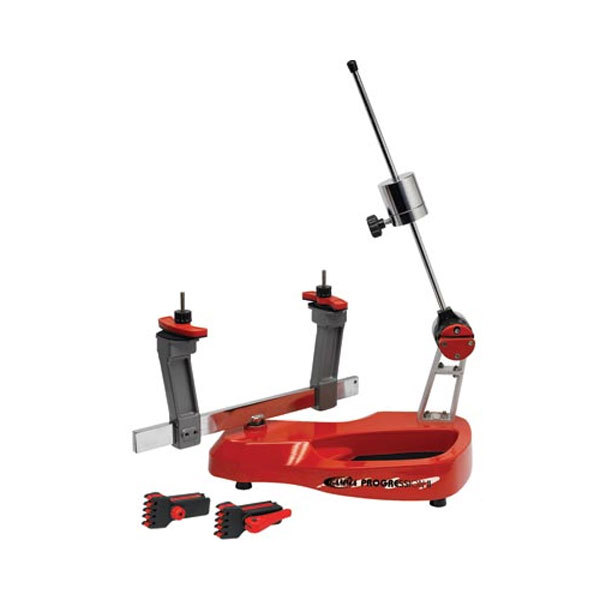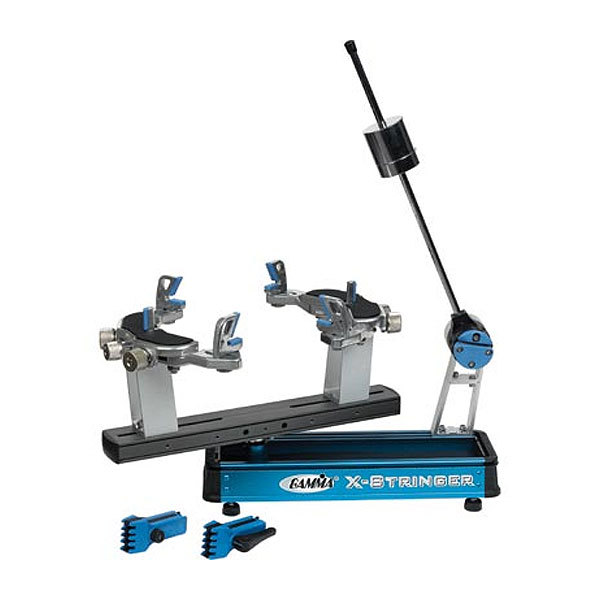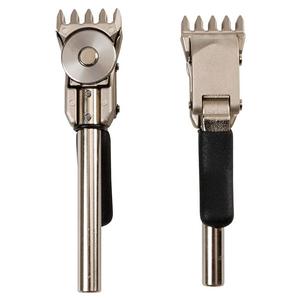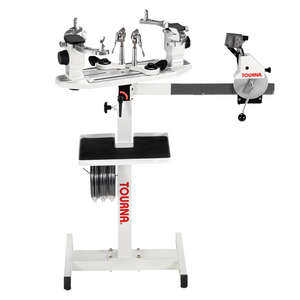By: Alex Myers
How many are tired of paying $30 or more every time they need to replace strings in a racquet. For competitive players or tennis families this can get very expensive, very quickly. When I was playing in high school, I had 8 racquets, and because of tension loss and string breakage, they had to be restrung at least every three weeks. At an estimated $15 per frame for labor, that added up to over $2,000 a year at a minimum. For a family with two or three children playing tennis, you can see how this could get to be incredibly expensive.
Luckily, because of a mistake that a local club made in breaking my racquets before a tournament, I convinced my parents to front me the money to purchase a stringing machine of my own. Since my mother is an accountant, the first thing she wanted to see was an analysis of the money being spent on the machine and how much I expected to be saving. At the time, I had two racquets that I had to restring every two weeks during the school year, and slightly less frequently during off-season times. So as a base calculation, I assumed that I would be spending approximately the same amount for the strings themselves, and would be saving $15 on the labor. Of course, gas prices were not $4/gal back then, so it did not come into the equation, now it might play even more of an impact.
 Weighing the Cost-Benefit Analysis
Weighing the Cost-Benefit Analysis
The general rule at the time was to essentially figure out how much you would save in one year, and put that amount into buying the machine itself. It is a large initial investment, but given the life of machines, saves an incredible amount of money. Almost every machine will come with a fairly comprehensive warranty that will last either 3 or 5 years. Typically manual machines will be 5 years all around, while electronic machines may have shorter warranties on the electronic parts.
Research, Research, Research
I spent a few weeks researching machines from different companies and it can be overwhelming, with some manufacturers offering products that look identical to others at a significantly reduced price. While tempting, I went with the company that had the reputation for incredible customer service as this was my first machine, and I could not have made a better decision. I purchased an Alpha tabletop crank machine, the predecessor to the Revo 4000, and strung well over 1,000 racquets on it.
Making Extra Money
The thing is, I originally purchased it for my own use, but once others found out that I owned a machine, it was more convenient to pay me to string their racquet instead of taking it to the club and waiting days for it. I would never suggest learning how to string on another person’s racquet, but once you have an understanding of the process, it’s not a bad way to help out others and make some extra money on the side.
Key Things To Look For
So exactly what do you look for when you want to purchase a machine? Despite all the bells and whistles, it really breaks down to three basic components: the mounting system, the clamps, and the tension head. Prices will range depending on the quality of each component as well as the type. To give an idea, my first machine was $600 while some of the more expensive go for over $10,000. Many people focus on the tension unit, but in comparison to the other parts, it is more an issue of convenience rather than quality.
The Mounting System
 The first thing I always look at is the mounting system. The two most common systems are referred
The first thing I always look at is the mounting system. The two most common systems are referred  to as two-point and six-point. Other variations exist, but the most common work in two different ways. The two-point system uses a lockdown mechanism that holds the frame at the top and bottom parts of the head, while the six-point system suspends the frame, with two contact points on the inside of the frame at the top and bottom. The other four contact points are along the outside of the frame around the shoulder areas. They work in different ways, but the goal is to properly support the frame so that it does not break under the extreme stresses of the stringing process. The racquet itself experiences more strain and wear during stringing due to the uneven tension applied around the head, so a quality mounting system is important to maximize frame life. Personally, I prefer the six-point system because they tend to be a bit quicker to mount, and I tend to play more flexible frames. I don’t want them to experience excessive distortion, but there is no doubting that a good two-point system is far and away better than a bad six-point system. The key is to get a quality system that you are comfortable with.
to as two-point and six-point. Other variations exist, but the most common work in two different ways. The two-point system uses a lockdown mechanism that holds the frame at the top and bottom parts of the head, while the six-point system suspends the frame, with two contact points on the inside of the frame at the top and bottom. The other four contact points are along the outside of the frame around the shoulder areas. They work in different ways, but the goal is to properly support the frame so that it does not break under the extreme stresses of the stringing process. The racquet itself experiences more strain and wear during stringing due to the uneven tension applied around the head, so a quality mounting system is important to maximize frame life. Personally, I prefer the six-point system because they tend to be a bit quicker to mount, and I tend to play more flexible frames. I don’t want them to experience excessive distortion, but there is no doubting that a good two-point system is far and away better than a bad six-point system. The key is to get a quality system that you are comfortable with.
Once you know that the frame is secure in the mounts, the often overlooked turntable should at least be given some consideration. Any reputable manufacturer will use a table with plenty of strength to resist warping under the tension of stringing. Unfortunately, there are lesser brands that make machines similar in appearance, but cut corners with lesser materials, and this is a good place to cut some expense. No matter how well the mounts support the racquet, if the table bends, the racquet will end up warped.
 Stringing Machine Clamps
Stringing Machine Clamps
So now, the hotly debated topic of clamps comes up. There are essentially two systems with a subset in one of them. The two systems are flying clamps, and fixed clamps. The fixed variety comes in two variations: dual-action and single-action. While the goal is the same, to maintain the tension that was pulled on the current string, the two systems do so in different ways. A typical flying clamp is essentially three parallel jaws and with one lever closes both gaps to clamp the string that is currently being tensioned, as well as the previous string, which acts as the anchor. A fixed clamp only has one pair of jaws, and clamps the string currently under tension. A single-action system is designed so that when the clamp closes on the string, it also locks onto the glide bar, while a dual-action system requires the base to also be manually clamped to the table. Both systems work, though typically fixed clamps are regarded as the superior option because the idea of anchoring against a metal table feels more secure than clamping against another plastic or polyester string. To further perpetuate this belief is that there are only a handful of machines priced over $500 that utilize flying clamps. Having used all of the clamping systems, my favorite is also the most common, dual-action fixed clamps, thanks to their versatility and my much more extensive experience with them.
Tension Head
So the part that everyone cares about is the tension head. Be honest, how many people have felt like they were going to get the best string job they have ever had back because they saw the club using an electronic machine? It’s human nature, when you go in and say you want your racquet at 60 pounds, and the stringer sets that into a computer, you think you are getting the perfect result. Well, that’s not necessarily the case. There are three general types of tension units, a dropweight mechanism, a spring-loaded crank mechanism, and the electronic machines.
 Dropweight Machine
Dropweight Machine
A dropweight uses basics physics, and a weight that is placed a specific distance along the bar in order to apply a set tension. With almost all dropweight mechanisms, it is necessary for the bar to be perfectly parallel with the ground in order to achieve the correct tension, but this is where a huge misconception occurs. Studies have proven that the bar can be within about 15 degrees either too low or too high and still achieve over 99% tension accuracy. I will bet that most players would honestly not notice the difference between 60 pounds, and 59.4 pounds.
Crank Machine
A spring-loaded crank mechanism is significantly easier to use. There is a knob that you turn in order to set tension. After that, just put the string inside the jaws, and start turning the crank until tension is reached and the brake activates. After moving the clamp, you simply push the brake back in and continue moving on. Many consider these machines the fastest, but also the most inconsistent. This is true and false depending on the stringer. Unlike a dropweight mechanism and a quality electronic machine, once tension is reached, the crank style stops pulling. The string begins to stretch, typically dropping slightly in tension by the time the clamp is moved. Some say this causes inconsistency, but realistically, during the rest of the stringing process and forever after until the strings are replaced, they will slowly lose tension. It should be noted that there is approximately a 10% difference in the reference tension that you would set on a crank machine vs. a “constant-pull” machine.
 Electronic Machine
Electronic Machine
The most highly sought after units of course include electronic tension heads, computer microchips, and motors. There is a huge misconception that all machines that are plugged into a wall outlet utilize the same technology and are equal. This is of course incorrect, as there really should be an additional distinction between electric and electronic machines. The typical electric machine will use a rotating drum in order to apply the tension and digital reference tension readout. What is conveniently left out is that these types of machines are usually controlled by a spring and have a very large hysteresis. This is essentially a measurement of how much the string must stretch, before the device recognizes that it is no longer pulling the correct tension and adjusts. Some electric machines will have a hysteresis of more than 15 pounds, essentially making them expensive crank machines with more buttons. Electronic machines on the other hand, will almost always be controlled by a microchip and load sensor and have much stricter measurements. For example, the Prince 6000 will adjust its pull if it senses that tension has dropped by as little as one pound.
So does this automatically mean that the only way to get a good string job with your own machine is to spend $6,000 on a Wilson Baiardo Stringing Machine? Absolutely not. The fact of the matter is that almost any machine is capable of providing the tools for a quality string job, but the machine is only a tool. The tension that is set on the machine is merely a reference point, and there is not a single machine out there that will give you a racquet back that is exactly at 60 pounds. What is infinitely more important is the consistency that it gives results. If you decide that given a racquet, string, and machine combination, you prefer your racquet strung at 55 pounds, even if the final result is closer to 45, as long as you like it and you can replicate it, the stringer has done his or her job. The largest difference between spending $300 and spending $3,000 is in convenience, assuming you choose a reputable manufacturer. As someone that has days when I have 30+ racquets to string, I wouldn’t be able to do it in a timely manner on a dropweight machine with flying clamps compared to a dual-action fixed clamp, electronic machine. It doesn’t mean that one cannot produce a quality job on a less expensive system, it just means that it takes a bit more time.
As if this wasn’t information overload as it is, this is really just the tip of the iceberg when it comes to stringing machines and the advantages of it. Depending on how much your family spends on stringing each year, perhaps it makes sense to consider the alternative of stringing yourself. It is easy to learn the basics, and provides the ability to take care of stringing without worrying about traffic or multiple trips to the club.
Learn more about the latest innovative tennis products at the Tennis Express blog.


